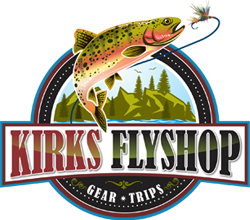
Rocky Mountain National Park Fly Fishing: 5 Places to Check Out
There are few angling experiences quite like Rocky Mountain National Park fly fishing. With breathtaking, abundant scenery and towering mountains in nearly every direction, the staggering nature of this place will leave you speechless. Unique to our area, Rocky Mountain National Park hosts five species of trout, two of which are native — The Greenback Cutthroat and the Colorado Cutthroat. Making for a unique Colorado fly fishing experience, catching a few of our highly coveted native trout make the trip well worth it. Fly fishing in Rocky Mountain National Park is a must-do for any angler and to help with trip planning, here are our five tips for where to go to make the most of your visit.

1. Moraine Park-Upper Big Thompson
One of the most well-known areas for Rocky Mountain National Park fly fishing is Moraine Park. The main attraction from an angler’s point of view is the Big Thompson River, which flows directly through Moraine Park. Throughout the lower part of the valley, the stream meanders through a beautiful meadow featuring complex holding structure, riffles, and pools. This stretch is known for its abundant population of brown and brook trout. Anglers beware: fishing in the meadow can be challenging as the trout usually see you before you can get to them. For easier-to-catch trout, hike up towards the Cub Lake Trailhead as the trees there can provide cover for easier approaches to the spooky trout. The further you move up the Big Thompson River, you will find more and more brook trout as well as Greenback Cutthroat — one of the rarest native trout in the west.

2. Colorado River Headwaters
On the west slope of Rocky Mountain National Park you will find where the Colorado River starts its journey to the sea. The Colorado River flows through a long meadow in the park called the Kawuneeche Valley. This section of the Colorado River is a medium-sized river winding its way through timber and meadows. Brown and brook trout call this entire valley home and many of the tributary streams support them, as well. At the higher elevations of the Colorado River and its tributaries, there are Colorado River Cutthroat — a native species found only in the Colorado River basin. To maximize your success while Rocky Mountain National Park, try a dry-dropper setup.

3. Glacier Creek
Glacier Creek is a beautiful freestone creek, perfect for Rocky Mountain National Park fly fishing. This special creek has four species of trout found in it including brown, brook, cutthroat, and rainbow trout. Unlike many other streams in the range, Glacier Creek is characterized by fast-moving riffles, boulders, and holes. The pocket water fishing is terrific here with dry flies being especially successful during the summer. For the adventurous angler, some stretches can be difficult to access but with a little persistence and bushwacking, you will be rewarded with quality fishing.

4. Wild Basin
For anglers seeking solitude and pristine environments, the Wild Basin area is the ideal destination for Rocky Mountain National Park fly fishing. This area has several creeks as well as many great high alpine lakes that all support healthy and abundant populations of wild trout. North St. Vrain Creek and Ouzel Creek are the two main creeks in this area. Both are fast-moving and have many obstacles to scramble over as you work your way upstream making for an interesting day on the water. There are brown trout in the lower areas but from Copeland Falls up you will primarily find Brook Trout and Greenback Cutthroat. If you’re looking for a good hike, there are several quality lakes in this area including Thunder Lake, which has excellent cutthroat fishing, Pear Lake, and the Hutchinson Lakes.

5. Alpine Lakes
There are many productive high alpine lakes for Rocky Mountain National Park fly fishing. It is impossible to cover them all but here are a few of our favorites (on top of the three mentioned in the Wild Basin). Lawn Lake is a very consistent place to catch Greenback Cutthroat and the 14-mile round trip lends to backpacking to get the most out of your efforts. Arrowhead Lake is one of our favorites and holds very large cutthroat. The only drawback is that it is a daunting hike at high altitude, and there aren’t any campsites at the lake. Lost Lake is another great one to try as it supports healthy populations of trout. Located in the northern part of the park, it’s worth your time to reserve a night or two of camping as the trip can be strenuous. Additionally, there are a few other lakes around that are worthy of a side jaunt.
Rocky Mountain National Park fly fishing is an experience worthy of newcomers and seasoned anglers alike. The wild trout, extraordinary views, wildlife, and unique environment is worth the trip no matter where you’re coming from.
Have a question about Rocky Mountain National Park fly fishing or fly fishing in Estes Park? Call our Estes Park fly shop to get the latest information on the park and let us help plan your trip to fly fish Colorado.

